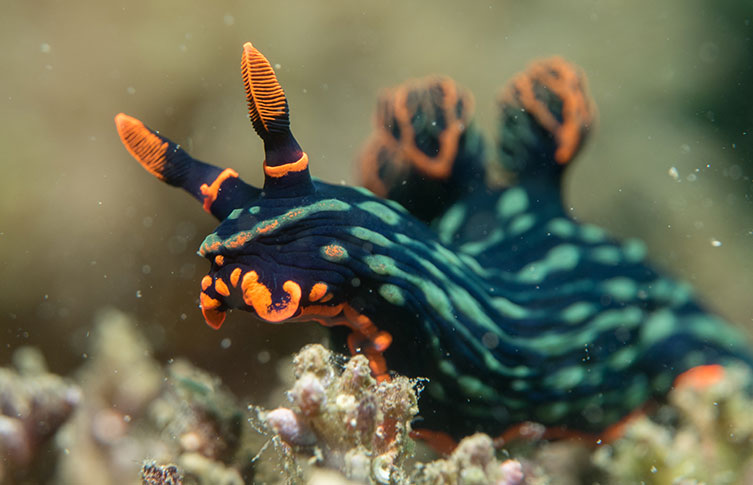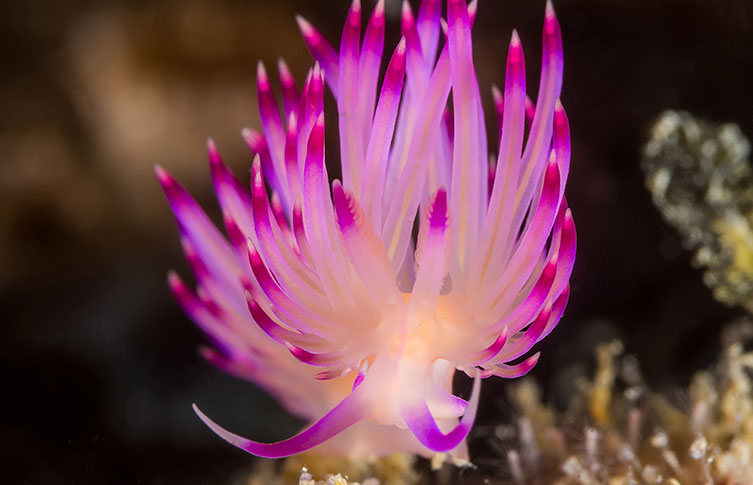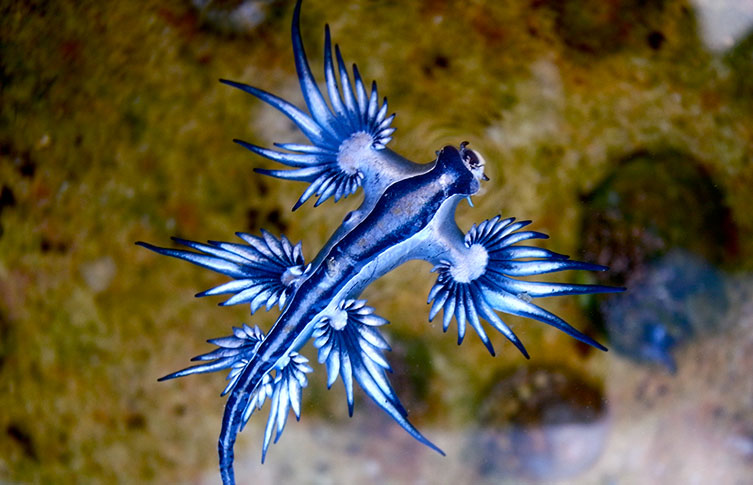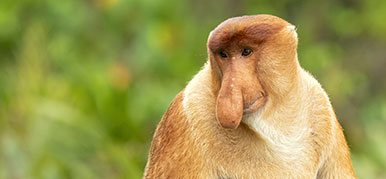Stinging cells, produced by cnidarians such as jellyfish and anemones, are one of ocean creatures' most effective defences.
This method of protection can keep almost all predators at bay - but not the kaleidoscopically colourful sea slug.
Stinging cells, produced by cnidarians such as jellyfish and anemones, are one of ocean creatures' most effective defences.
This method of protection can keep almost all predators at bay - but not the kaleidoscopically colourful sea slug.
Discover the incredible world of sea slugs that commit serial stinging-cell crimes.
Nudibranchs, commonly known as sea slugs, are a group of shell-less marine molluscs. Their name means 'naked gill', referring to the breathing apparatus on the outside of their soft bodies.
These gastropods can be vibrantly coloured, with hues from bright purples and vivid blues to fluorescent oranges, earning them common names including 'dragon' and 'clown'.

Dorid nudibranchs such as this variable neon slug (Nembrotha kubaryana), use toxins made by their prey and release them as a defensive mucus © Kim David/ Shutterstock
But these slugs aren't joking around. Some species of nudibranch have turned to a life of crime, robbing prey of their only defences: their stings.
Nematocysts are the venomous stinging cell organelles produced by cnidarians such as jellyfish. They're a highly effective defence mechanism, able to keep a number of threats at bay.
But the sea slugs in the group Aeolida are practically impervious to these spiny javelins, despite their soft bodies.
The aeolid animals employ a coating of chitin, a glucose derivative, in the front part of their digestive system which can deflect the cnidarian attacks. Any harm done is rapidly repaired.
Deflecting the blows and showing no weaknesses, the nudibranch will continue to prey on the cnidarian, most commonly a sea anemone, in the hopes of a well-earned meal.

The long cerata on the backs of aeolid slugs like Flabellina rubrolineata are used not only for storing stolen stinging cell organelles but also to absorb oxygen for the animal to breathe © Suwat Sirivutcharungchit/ Shutterstock
Instead of digesting the nematocysts, the slug steals them for itself. The acquired cell organelles are then recycled into the flamboyant, tentacle-like cerata on their backs.
The now stinging organelle-enhanced nudibranch, if it ever finds itself at risk, will re-fire the hijacked nematocysts, as though they were always their own.
Sea bunnies, the species Jorunna parva, may look a bit like rabbits, but they are actually a type of sea slug. These one-centimetre-long creatures belong to a group known as the dorid nudibranchs.
In the video below, Museum scientist Dr Suzanne Williams explains how their adorable features are actually functional.
Glaucus atlanticus - also known as the sea swallow, blue angel or blue dragon - looks especially unusual. The cerata of this species are not on its back but positioned like wings, stretching out from its sides, with 'feathers' of varying lengths.
This otherworldly looking species, first described in 1777, floats at the surface of the water on its back, using currents and wind to carry it across the ocean.
Like many other nudibranchs, the sea swallow harnesses the venom of its prey. But this small slug will also take on colonies of floating cnidarians. This includes the Portuguese man-o-war, an open-sea colonial animal that is closely related to jellyfish and whose sting can sometimes be fatal to humans.

Glaucus atlanticus float belly-up and are carried along in the ocean currents ©Sylke Rohrlach/ Wikimedia Commons
But the sea swallow is picky when it comes to harbouring stinging cells. Instead of taking everything it can get, the slug only stores the larger of the two main types of nematocyst made by their buoyant prey.
This is probably to ensure that the slug has maximum power when stinging its own predators.
A specimen of Glaucus atlanticus that was collected on the Challenger expedition is held in the Museum's collections.

The sea swallow specimen from the Challenger expedition is stored on a slide and preserved in glycerine
At a length of just 12 millimetres, the specimen was pulled from the surface of the Pacific in July 1875. It was then preserved in glycerine on a slide.
The species was originally described inaccurately, resulting in an incorrect labelling when it was accessioned to the Museum in 1888. The small slug was originally believed to be Glaucus longicirrus, but this name was later acknowledged as a synonym for G. atlanticus.

A report on the Nudibranchia collected on the Challenger expedition during the years 1873 to 1876 (Bergh, 1888)
Sea swallows may look delicate in real life, let alone in glass.
In the late nineteenth century, Leopold Blaschka and his son Rudolf created over 10,000 detailed glass models of sea-dwelling invertebrates, including a replica of G. atlanticus.
Museum Conservator Chelsea McKibbin worked on the sea swallow model before it went on display at the Museum.
Chelsea says, 'These were very well-known scientific, anatomical glassmakers. Nobody has since been able to replicate what they have made. They're amazing.'
At 5.5cm in length and 3.75cm at its widest, the model is close to the size of a live sea swallow.
'When you take the living animal out of the water, they shrink back and collapse.
Then they are stored in alcohol, which can cause further shrinking, so they end up quite small.'

Museum Conservator Chelsea McKibben worked to fix the finger-like structures of the delicate glass Blaschka model
Constructed from several individual and exceptionally delicate pieces of glasswork, the model needed a little conservation before it could go in display.
'The glassmakers' method for attaching appendages is animal glue - so the brown adhesive you can see. It is applied to glass, which is a really smooth material, so over time some of the appendages had fallen off,' says Chelsea.
'I have reattached them with a conservation-grade adhesive. One of the back appendages was also missing, so I have had to replicate it.'
Using monofilament, which is similar to fishing line, Chelsea made prototypes and eventually the final reconstruction of the missing 'wing', finishing by painting it the same shade as the original model.
'It sounds really easy, but it actually took me around a month to get to this point.'
Although the replica is displayed alongside the original model, it will not be permanently attached.
Chelsea explains, 'I want to make sure we are accurately depicting the specimen, but I don't want to attach it directly because it is not an original part.
'I'll adhere the final replica onto a little pin, which can be fixed to the mount, so that it looks attached.'

Just how weird can the natural world be?
Don't miss a thing
Receive email updates about our news, science, exhibitions, events, products, services and fundraising activities. We may occasionally include third-party content from our corporate partners and other museums. We will not share your personal details with these third parties. You must be over the age of 13. Privacy notice.
Follow us on social media